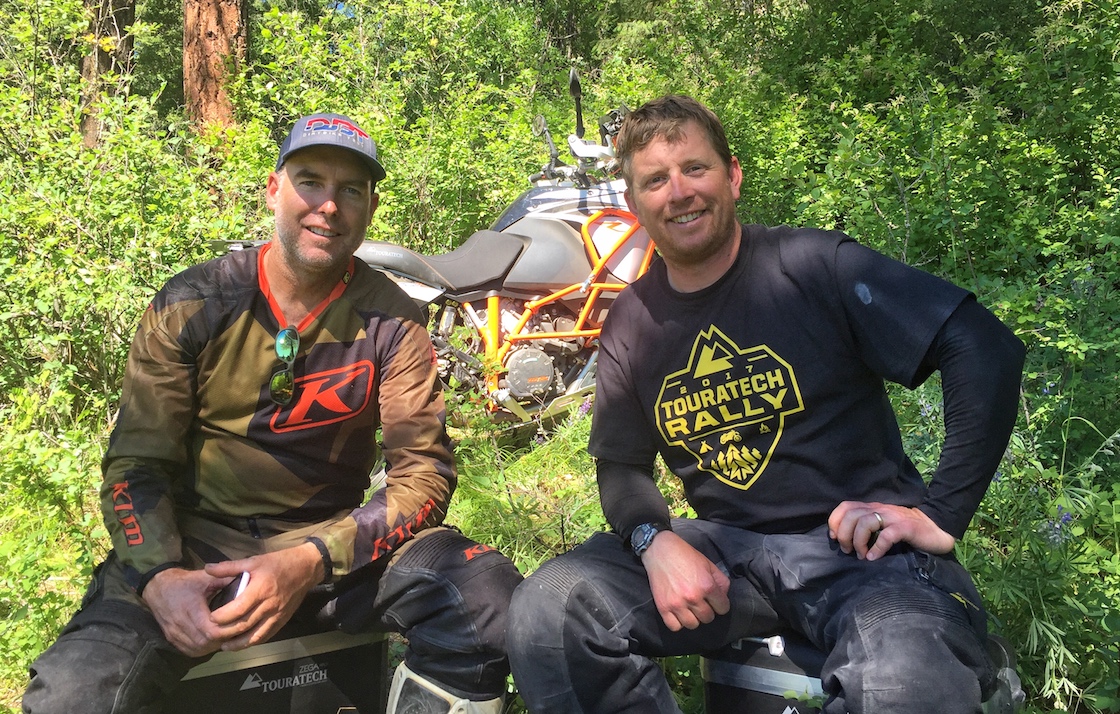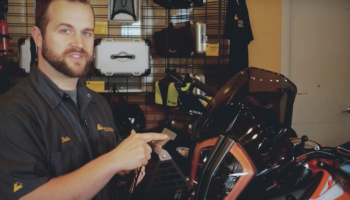Jimmy Lewis: I’m Jimmy Lewis with dirtbiketest.com
Paul Guillien: And I’m Paul Guillien with touratech-usa.com
We’re here at the Touratech Rally and we just got our hands on a brand-new KTM 1090 Adventure R. We’ve outfitted it with all the Touratech parts and we’re gonna go out and take it for a first ride, see what our thoughts are about this new motorcycle.
Jimmy Lewis: Okay Paul, so we got to spend some time on the 1090, the Touratech one. I got to ride a 1090 Adventure R back in New York a few weeks ago for a long time and I got to play around on your bike, and you just got to take it out for a ride, so what do we think?
Paul Guillien: Well, I’m liking an awful lot. My favorite type of bikes are those with 21 inch front wheels for adventure riding. I’m one of the co-founders of the Backcountry Discovery Routes, so when I’m evaluating a bike, I’m always thinking, is it good for a BDR? Is it good for forest service roads? And that sort of thing. Is it good for getting to those roads? And I was really pleased with it.
Jimmy Lewis: For me, I have a long background on riding adventure bikes and all different kinds, especially KTMs from the very early 950s to … I currently own an 1190 standard and an R, and right away when I got on this bike, I’m like, “This is an improvement.” There’s really not that much change from 1190. It’s kinda small stuff. But it’s bigger than you would think and actually smaller than you’d think, so I’m pretty impressed in a very performance-oriented aspect. I think it’s not only as good as the older bikes, it’s better.
Paul Guillien: Yeah, I like it better than the 1190. I liked the 1190, but I think they made it better by shaving some weight out of it. It doesn’t have all the power that the 1190 has, but I never used that power anyway, so I think it’s really a good balance for off-road riding. It’s got plenty of power. I like the traction control mode on it. I think that allowed me to play and have fun. I was able to get the bike a little bit sideways but not too much for my skillset. So I really enjoyed that. I think the traction control on the KTM 1090 Adventure R is great option for a lot of guys.
On the ABS side of things, I rode it without the ABS on. I had the ABS off. But then when I switched it on, on the off-road mode it’s full manual on the rear so you can skid-steer and really have good feel for it, but it’s got the ABS on the front brake, which I thought was pretty good. It actually would bite enough that I could feel the front end moving, and then it would release.
Jimmy Lewis: So that’s essentially off-road ABS, and what that does is it allows you to lock the rear wheel if you want to, but you still have anti-locking in the front. Off-road, the way we like to think about it, is the rear brake is more for control than slowing you down, so sometimes locking up your rear wheel is a good thing. We want to do it to control the bike. So being able to lock the rear wheel up but still have somebody saving your ass when something goes wrong with the front brake, I.e. skidding, it kicks in and stops that. So it’s pretty cool.
A point if differentiation on the 1090 is that it doesn’t have the lean angle stuff that the 1290 and the older 1190 had. But in reality, that’s a pretty extreme thing. It really does work, but for this kind of bike, you really don’t notice it.
Paul Guillien: So one of the ways they shaved weight out of the KTM 1090 Adventure R is by removing the center stand, so one of the drawbacks there is that if you have a flat tire, it’s a little harder to get that rear wheel off the bike. They also took some weight out of the motor.
Jimmy Lewis: Or the front wheel.
Paul Guillien: Or the front wheel. So they took some weight out of the motor, the rotating mass. I think that contributes to the lighter feel. It’s still got plenty of power. What do you think about the motor?
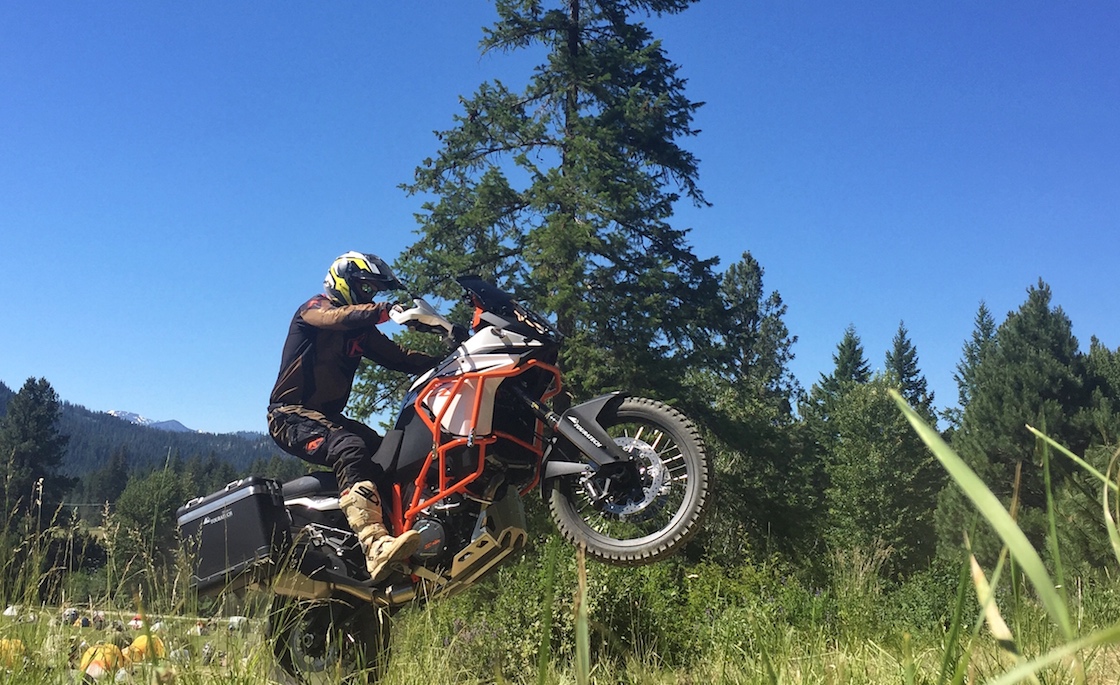
Paul Guillien: Or the front wheel. So they took some weight out of the motor, the rotating mass. I think that contributes to the lighter feel. It’s still got plenty of power. What do you think about the motor?
Jimmy Lewis: Yeah, it’s definitely … for me, I noticed the reduction of power right off the bottom. Right when you start cracking the throttle. And I played with all the modes, and most of the time when I’m riding the bike I’m putting it in sport mode because as much as I like smooth power, I want it to be very responsive. If there’s anything I felt it lost, it’s just probably to the maybe three to five percent throttle where it doesn’t have the pickup or the response that I’m used to on my 1190. I wish I could get that back, and for sure, when I get one of these, I’m going to play with it to get that, but other than that, and we’re talking about 99% of the time you’re riding, I love it. I don’t notice there’s a reduced power because it spins up so easy. It picks up so easy. Especially with the traction control off. And as somebody that rides around with the traction control off most the time, I liked leaving it on when I’m just adventure riding because it is fun.
It’s not like it’s working the butterfly valves, not doing the ignition cut, so even when you turn the throttle, it says, “Okay, I’m gonna give you the throttle without going uh-uh-uh.” It just smoothly does it. So it lets you be playful with it. You can get the back end to slide, and when it’s just about the time when it’s too much, it cuts a little bit of power. It doesn’t open the throttle so much. It’s almost kind of strangely magical.
Paul Guillien: The traction control is magical in that when you’re doing it, unless you really think about what it’s doing, you almost don’t notice it. You just think that you have good throttle control. And that’s really nice.
Jimmy Lewis: Where you do notice it, though, is in sand. Sand or mud.
Paul Guillien: Yeah. For sure.
Jimmy Lewis: So what it does there, and like I said, it’s really good, and there’s times when you just want the bike to spin. That’s just the way that we’re used to going through stuff. Even though it does a good job of cutting the power and trying to get traction, you’re just weird because you’re just turning the throttle and it just not accelerating, and sometimes that leads to sinking in the sand, sinking in the mud. So sometimes that’s why they allow you to turn traction control off on the KTM 1090.
Paul Guillien: I think it’s great to be able to turn it off for sand, but comparing this bike to some of the other 21 inch front wheel bikes on the market, those traction control systems are horrible compared to this because they cut the spark, and I think it’s un-rideable. Yes, you can suffer through it, but it’s really horrible. On those bikes, I always shut the traction control off. On the KTM 1090 Adventure R, I am going to leave it on most of the time.
Jimmy Lewis: Yeah, because when they come back on, it’s not a smooth on and off, the power. When it decides to start sparking again, it usually does these kind of lunges.
Paul Guillien: For me it’s when it stops sparking. Suddenly I fold forward. When it comes back on it’s usually a relief. It’s when it cuts out suddenly that bothers me.
Jimmy Lewis: I’m the exact opposite.
Paul Guillien: Yeah. I’m not surprised, ha ha. So I always have to shut off the traction control on the BMW F800GS and the Honda CRF1000 Africa Twin. I always have to shut it off. With this bike I’m always going to leave the traction control on unless I’m in deep sand or some sticky situation I’m trying to get out of.
Jimmy Lewis: Yeah, I agree. And after that, like I said, the power, it’s enough to get you in trouble on the street, pass semi trucks, whatever you need to do. It can be a hooligan bike if you want it to. Even after today, I took a quick spin on a 1290, and I’m like, “Well, that’s awesome; I just don’t need that for the kind of riding I’m gonna do.”
Paul Guillien: Yeah. Very few people need the power that the bigger bikes have. I think this has plenty. We did have to get around a couple of cars in some tight twisties today, and it has that power that is just ‘right now’, you know, you just get on it, and you get the job done really quick. So it’s nice for that, but off-road it’s got plenty of power. But I really do think it’s a much better bike than some of the other 21 inch front wheel bikes on the market in terms of the technology. It’s better with the traction control, better ABS, more power. On some of the older models you’re really buzzy at highway speeds. You’re topped out and high gear, especially if you’ve geared down the sprocket for off-road riding. On the KTM 1090Adventure R, it’s simply not a problem.
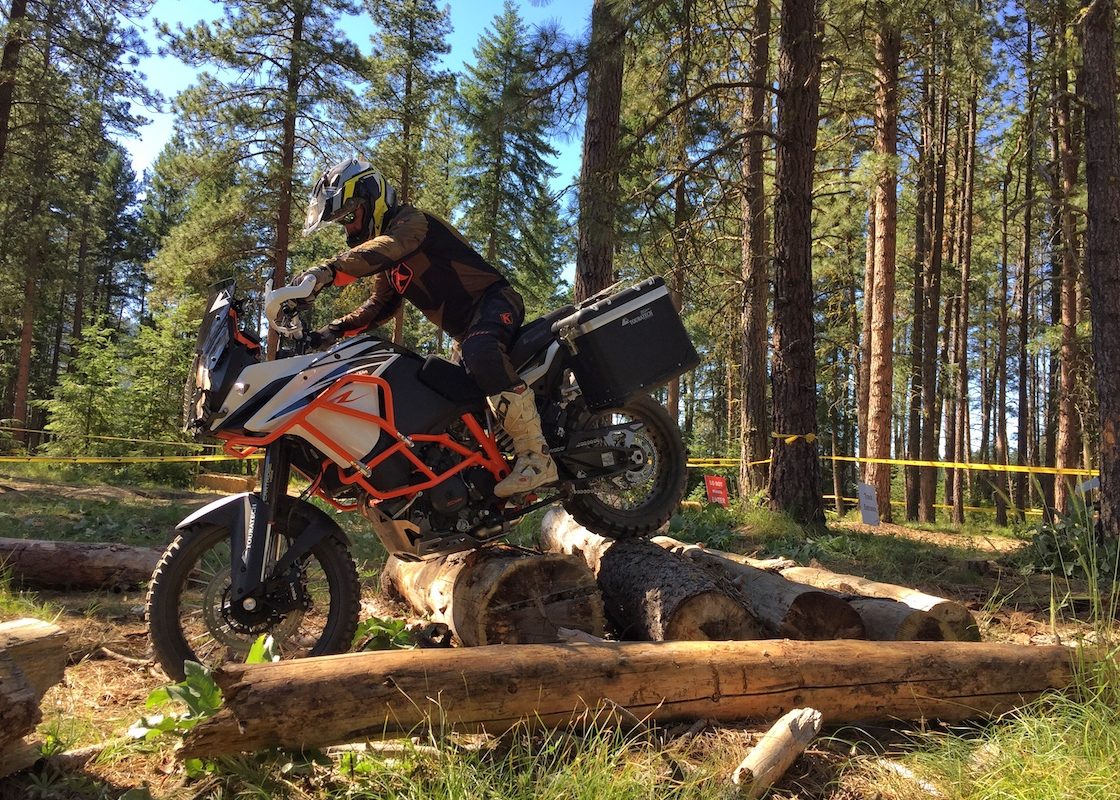
Jimmy Lewis: And then another thing that we haven’t touched on is the suspension. I know that the one thing I really liked about the African Twin, for instance, is that they had really good suspension control. It’s not magical, like there’s no magic for any of the adventure bikes. They’re heavy bikes, you’ve got to be careful. But Honda really did a good job with the suspension on the Africa Twin, and that was an area that I think KTM paid attention to going to a true PDS Shock, which is a twin piston … or it actually has a bottoming cone second piston there that kind of slows it down. And Stock, I’ve spent a lot of time on a Stock one, it’s a big improvement. It doesn’t blow through the stroke. It just feels like you have really good damping control. It will still bottom and bottom easy by dirt bike standards, but it also tells you, “Hey, you’re on an adventure bike. You might be going too fast.”
Paul Guillien: It makes those water bars a lot more fun than the older models, doesn’t it? We were able to hit some of those today and I was really pleased. Of course, the bike we’re on has Touratech suspension, with the Cartridge System in the front forks and the Extreme Shock in the rear, but I was getting some good air off of these water bars and I didn’t have that hard, mechanical bottom-out that you sometimes feel on the other bikes. So I was really pleased with the suspension.
Jimmy Lewis: Right away I noticed the difference in suspension from Stock to Touratech, especially the fork. That cartridge just gives it … it’s more consistent. There’s more damping in there. And then I think Touratech Suspension is up on spring rates, because it’s sprung for a heavier rider, maybe a little more aggressive also, to be able to carry luggage, especially in the rear. The fork, you could really feel the damping. In fact, I think all I did was add a couple clicks of compression just because I wanted a little bit more damping, and then out back the shock was a little bit softer than I wanted initially, so we added some definitely a little bit, three to five clicks of low speed and a couple of clicks of high speed, and it just gave it that little bit more control. Overall it’s very similar to the Stock; it’s just better damping feel is what I noticed when I ride between the two bikes.
Paul Guillien: I was riding your clicker settings today. I didn’t change any clickers, and I thought it was fantastic on the forest service roads. I think this bike, for cruising the forest, forest service roads, Backcountry Discovery Routes, Touratech Rally, style riding, I think this bike is just awesome. It is really a blast to ride.
Jimmy Lewis: And the other thing that’s quite noticeable about it is the weight. I think compared to 1190, it’s maybe even less than 10 pounds. I think it’s 21 or 22 pounds lighter than a 1290. But when you ride it, it feels 20, 30 pounds lighter. Some of it’s just in maneuverability for some reason, and I think it’s the spinning stuff inside the motor, and I think also the way that they’ve got the power, kind of less snappy. You don’t get the bike that little bit out of control where it snaps, and when things start snapping on adventure bikes, that’s when you feel how heavy they are. This one’s just not doing it. So it feels way lighter than the numbers would lead you to believe.
Paul Guillien: Yep. The KTM stated number I just saw on the website, is 507 pounds fully gassed up. This is the weight they’re claiming. They’re claiming 456 dry weight. But I have to say, once you’re rolling, the weight disappears. You don’t feel it. I did feel every bit of the 507 pounds when I was turning around on that single track that we decided wasn’t passable on this bike, at least for me. It was a little tough to get around on that. So definitely it’s not a dirt bike, but as far as adventure category goes for 1,000 cc plus, it’s pretty darn light.
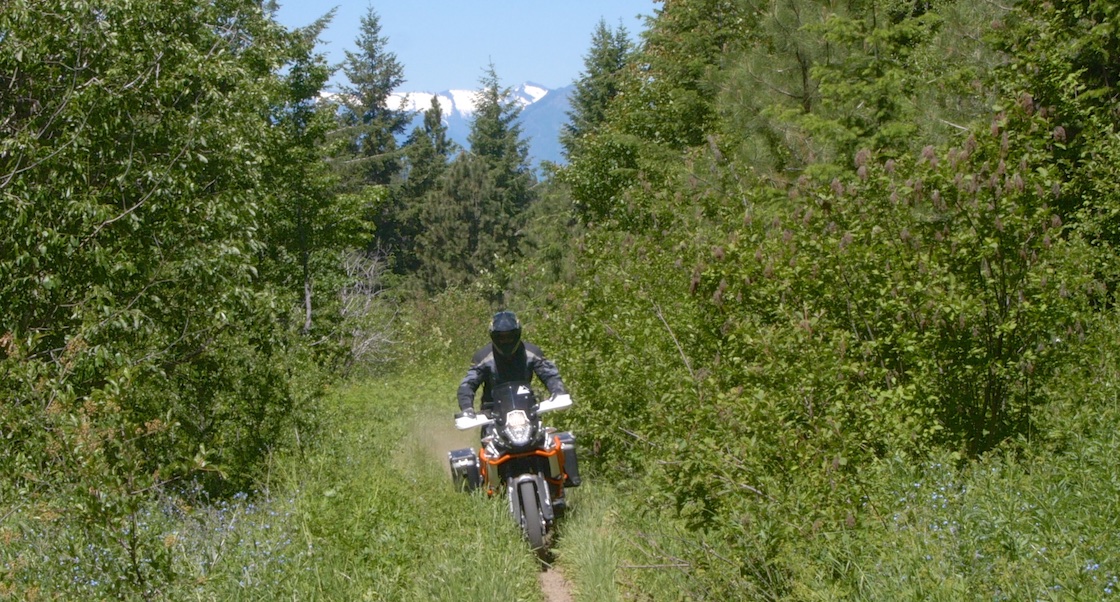
Jimmy Lewis: When you’re doing stuff, you’ll see in the video when I’m bouncing the bike around, hopping and hitting things, as long as everything’s going great, you’re in line, you’re landing smooth, it’s fine. You don’t feel the weight. Sure. And it doesn’t matter whether it’s 507 pounds or 520 or 450. When that starts going the wrong way, it goes the wrong way. It’s just this one, it masks it at least as good as anything else. It’s not top-heavy weight. Some of the bikes tend to have a lot of things up high. This one actually feels a little bit more like the Boxer, the Flat Twin, where the weight’s down low. Maybe not to that level, but it’s definitely a lighter-feeling bike.
Paul Guillien: You mentioned the Boxer. When I was out there riding it, we were going through some very twisty roads, and I was thinking it doesn’t fall into the corners quite as quickly and as much fun as a Water Boxer does. If I’m riding in the Alps on paved roads, I’d still grab a Water Boxer for that. It doesn’t have that sort of snappy road feel. It’s got all the power. It’s 125 horsepower, so it’s the same power as the Water Boxer, but it really makes a difference going from the 19-inch front wheel to the 21.
Jimmy Lewis: On that note, when I’m riding those two different kinds of bikes, the Boxer and the Flat Twin to me, it’s more of a relaxing ride. When you’re on the road, it’s … this one’s kind of, gas it. Go faster. It wants you to go faster. The Boxer is just happy to kind of lumber along. In some ways that’s good, because this one, even when you’re off-road, it’s going, “Gas it. Twist it.” It just has a little more. It’s comfortable. It’s not that it’s uncomfortable. It’s more of an aggressive comfortable, and it feels like it wants to be sporting. Maybe that’s why they say “ready to race.”
Paul Guillien: That’s exactly right. It’s a KTM and is ‘Ready to Race’. It brings out the inner hooligan in you. There’s something about it. It just sends signals to your brain to get on the gas. But fortunately it’s got some of the computer intervention that allows guys with my skillset to still be safe out there even though the KTM thing is talking to our brain and encouraging us to twist the throttle. Those are really safety features, and that’s what I like about the electronics: the ABS and good traction control. I think that’s a great feature for a lot of guys.
Jimmy Lewis: It’s safety, but they didn’t suck the fun out of it. So the KTM, I think it comes with a nice piece of plastic in front of the motor as a skip blade. Touratech has a super nice Skid Plate that goes on the front. You know you’re gonna bump into something, especially if you do dumb things like I do. Those center cases are gonna hit something, or rocks. Mostly rocks and stuff is going to come flying up. It’s a good little investment there.
The Upper Crash Bar is at the top to protect the bodywork. I try not to drop my bike, but it happens, and I know that those plastic bodywork pieces are, like, $200 each. The plastic piece underneath there. I know because I’ve broke some before. Just tipping over, of course.
And then the windscreen, you’ve got a little bit of a taller windscreen, so for moving down the road. I really like the short one when I’m doing aggressive stuff, but I don’t really do that that much even though that’s what all the videos show me doing. I usually am just out kind of cruising around and riding. In a reality, I’m never happy on one of these bikes unless I’ve got the ability to mount panniers. Panniers, soft bags, something like that.
Above and beyond that, the racks on the back, and people kind of forget this, they do help it when it tips over. It doesn’t start bending mufflers, you don’t break off turn signals and stuff, even when those things are there, and a lot of times I go down that single-track trail that I shouldn’t and I have to turn the bike around. That is a great lower place to be able to pick up and move your bike. It’s probably not the selling feature you want, but I enjoy it.
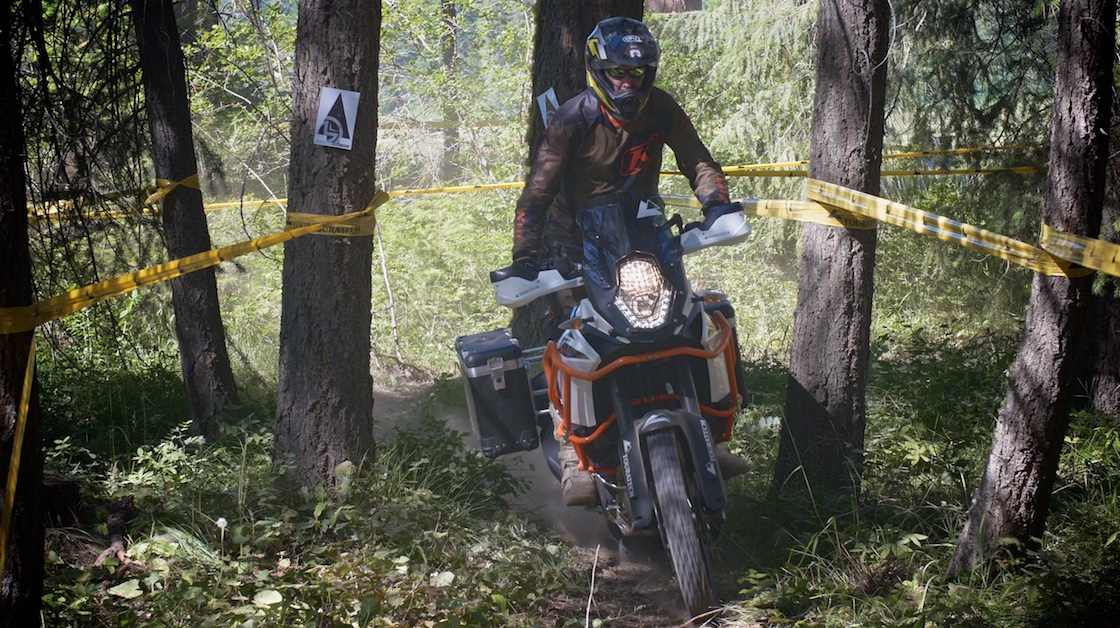
Paul Guillien: I had to do that once today on that single-track turn-around section myself. I would like to talk about the dongle. So on our old KTM 1190, we never have the dongle, and we finally ordered one just in time for the 1090. So we’ve got the 1090, we put the dongle in it …
Jimmy Lewis: Let’s explain what dongle is. It’s a plug. It’s just simply a plug that plugs into one of the wires that’s underneath the seat, and it allows the computer to keep the settings that you turn the bike off with. So when you set your ABS to a certain level, maybe you set it to off-road or maybe you want it on no traction control, when you turn your key off, when you turn it back on, it’s the way you left it, which I think all bikes should do that. I think it should come stock with this. But I guess the lawyers don’t like the bikes to do that. But I really think the dongle is probably the single best modification you can install on the KTM 1090 Adventure R.
Paul Guillien: It absolutely is. And what it does is it overcomes one of my biggest objections to this bike. The biggest beef I have with this bike is the complicated menu. You have to double-press the buttons, scroll through the menus and try to figure it all out. It’s really complicated.
Jimmy Lewis: Hold till throttle’s closed.
Paul Guillien: Yeah. It’s like a whole procedure. Once you’ve ridden the bike a bunch, it becomes natural, but when you’ve been on different bikes and you jump on this and you hit the dirt and you go to switch modes and your buddies ride off, you have to pull over and you’re trying to remember the menu and all this stuff. So this dongle solves all of those problems, which is great. With some of the other 21-inch front-wheel bikes, every time you cycle that key, you’ve got to turn off the traction control, you’ve got to turn off the ABS. This with the dongle remembers it, and it really makes this bike just about perfect in my view.
Jimmy Lewis: So it has the following ride modes: Sport, Street, Rain, and Off-road. I know Off-road cuts the power quite a bit. It just tames it. In reality, it’s really good. Then you can actually be aggressive and it doesn’t respond to aggressively. Sport, I wish it was sportier just right off the bottom, but once that thing’s maybe up to 2,000 RPMs, it’s doing its thing. It’s plenty sporty up there. Rain is really subdued. It’s like Off-road plus. I rarely ever ride it in actual rain, but I have used Rain mode for riding in mud, where it’s just greasy, slippery, where you’re not moving much. When you’re not getting stuck in mud, but it’s slippery. It saves your ass. But then traction control does tons of work. You can almost leave it in street or off-road with the traction control on and it does the same thing. The different modes are kind of a nice feature.
Once you learn where that setting is, you can do it on the fly. To turn the traction control on and off, you have to be stopped, and to do the ABS you have to be stopped.
Paul Guillien: You have to be stopped, or just close the throttle?
Jimmy Lewis: Stopped. If the wheels are moving, the map won’t even show up on the device.
Paul Guillien: Gotcha. So here is my big question for you Jimmy. If you owned an 1190, would you sell it to buy the 1090?
Jimmy Lewis: Yes. Mostly for the weight feel and the suspension performance. I’ll know for sure when I start playing around with it whether it’s something to do with the exhaust system. Maybe there’s some sort of ignition mapping or small intake change just to get a little bit more throttle response. I like how quiet the bike is. It does have a good sound, but it’s quiet, and that’s something I always kind of appreciate in a bike. I’m looking for just that little bit of throttle response.
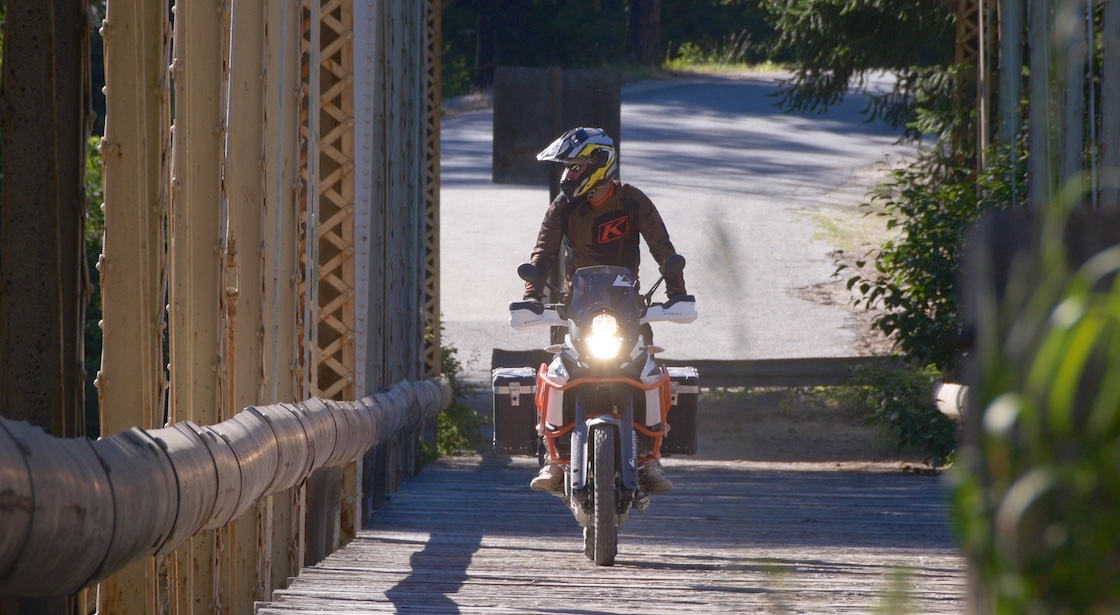
Paul Guillien: Did you notice this bike comes off the showroom with TKC80s?
Jimmy Lewis: Uh-huh. That’s good.
Paul Guillien: That’s pretty cool.
Jimmy Lewis: I like an open block, an open pattern knobby, and that way you can just take it and ride it right out in the dirt. You don’t have to go get a second set of tires.
Paul Guillien: Which is exactly what we did. We just bought this 1090 Adventure R this week. We bought it, bolted the Touratech parts on it, and brought it here. I think Jimmy got on it at mile two and we’ve probably put 80 miles on it, I would say, between the stuff that you did yesterday and the stuff I did today. Yeah, out of the box, it’s pretty darn good.
Jimmy Lewis: The brakes are pretty much awesome. There’s so much power. The KTM levers are so easy to adjust and fine-tune. They have good feel, nothing goofy, and if you can’t get that brake to do everything you want, then you need to practice more.
Paul Guillien: I remember the first time I rode the KTM 1190, charging down a forest road and I was, like, just one finger on that front brake and I had plenty of leverage. It felt so good. And this feels exactly the same. It’s one of my favorite things about the 1190… that one-finger front brake. I also feel like the clutch pull is really buttery and easy on this. It’s got really linear engagement. It just feels really nice.
Jimmy Lewis: Being a hydraulic clutch, that’s really nice. It kind of self-compensates. The pull isn’t that heavy, and the throw isn’t too long to get it to engage. Some of them have a long throw. It’s just, when you really want to use it to boost the power, it’s there and ready to go.
Paul Guillien: Yeah, I agree 100%. What do you think about the throttle? Did it feel linear and good for you?
Jimmy Lewis: It’s really light. The pull is light. You’re twisting a wire. You’re not pulling a cable. It’s picking up your sense. For me it’s a little bit on the light side, but I get used to it, and it’s that, like I said, that first initial maybe 3% where I wish it was a little more spiky maybe only on the sport mode, but other than that, once you’re going it’s very wrist-to-rear-wheel. There’s not a lot of … when the traction control is off, if you want it to spin up, it doesn’t take much. You can spin it right up. So it’s there. It’s just if you’re used to really pulling the throttle, you’re not gonna have to pull much.
Paul Guillien: The last bike I rode was the Africa Twin, and then I jumped on this. The first water bar that I came into, I gave it a handful, and I had the windscreen a lot closer to my helmet than I expected because it really launched… because the throw was just much more precise. Less wrist action equals result, as opposed to dragging the cable through the housing. So I really noticed that, especially in the first half hour.
Jimmy Lewis: Yeah, that’s the good thing about riding a couple of different bikes, switching them around, things like that stick out. And you either say, “I like this.” I don’t always say it’s good or bad, it’s just like this characteristic suits me. When we talked about that initial throttle, you liked that, I want more. It just depends on the rider. Same thing, it’s a benefit for you, it’s not for me. So I’ll mess my bike up and I’ll let you ride it and you’ll go, “I don’t like it.”
Paul Guillien: Yeah, absolutely. So the 1190, the first time I rode that motorcycle, it was at the KTM Rally and we were riding it all day on demos. I got on that thing, and when I got off I was like, “Whoa, that thing is hot under the seat!” And I immediately emailed Germany and I said, “You guys gotta make something that will work on the heat on this bike.” I rode this thing for two hours today, and not once today did I think, “Oh, God, it’s getting warm under my legs.”
Jimmy Lewis: I didn’t notice it either, but I’m the guy that rode a lot of miles on 1190s, and even the standard one, I never noticed it. A lot of times it was actually in the winter, I liked it. The little bit of heat I was getting. But I never really got that burn until I rode it in traffic once. I really got in a lot of stop and go traffic and I’m like, “Now I know what they’re talking about.” I didn’t really simulate that when I was riding around today. I stand up a lot, so it’s not a big deal. It’s more when you kind of sit down. The 1090 Adventure R does have some sort of little plastic piece in there. I think that might kind of channel some of the heat out of there. I know that was a big enough issue on the old one, on the 1190, that people were complaining about.
We’re not 100% sure on fuel range, but to me, I’m sure it’s gonna go every bit as far as an 1190 would. I wish the tank were just … actually I don’t want it any bigger physically. I wish there was more gas hidden on that thing, because especially when we’re riding around northern Nevada, I can use the extra fuel range. I know there’s some options for some side-mounted tanks and things that will get me to where I need to go with that better than carrying gas in bags and stuff.
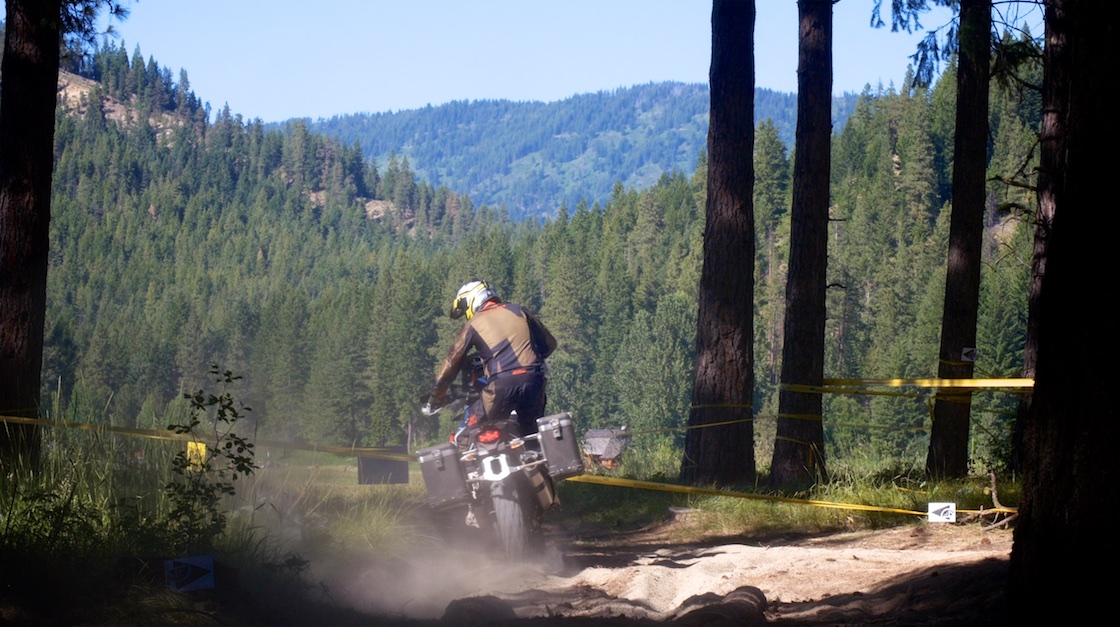
Paul Guillien: What I can tell you is that between your riding yesterday and my riding today for about two hours, we did burn all the way down to the last bar.
Jimmy Lewis: That’s a good thing, because you want me to go hop over logs and things. Taking that extra two or three gallons off the top makes a big difference in the way the bike acts.
Paul Guillien: We were not doing economical riding, either one of us, I can tell you that.
Jimmy Lewis: Yeah. We sweat as much gas in that thing as we could.
Paul Guillien: Well, thank you for listening to our thoughts on the new KTM 1090 Adventure R. It has been a blast to ride. It’s been fun to sort of compare and contrast it to some of the older KTM bikes and some of the other 21-inch front wheel adventure bikes on the market, so I hope you enjoyed it.
Jimmy Lewis: I’m not done riding it. I’m going to take it out and ride it a little bit more now. I’ve got a lot of time on one previous. I’m gonna be getting one here pretty soon and I’m gonna start dinking with it to kind of make it a bit more dialed in for me. And that’s one thing about these bikes, is they’re easy to customize and make them yours. I think the platform is great to start with and I’m stoked to be able to get one.
Paul Guillien: I’ll make sure to send you a Touratech Catalog.
